Join More Than 50,000+ Subscribers and get latest camera news and rumors
NEW CAMERA VIDEOS ON YOUTUBE
|
By admin, on January 23rd, 2017
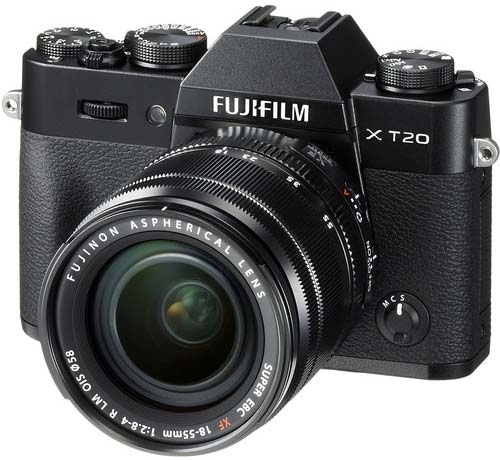
Fujifilm created a Dangal by announcing X-T20 camera a while ago. The X-T20 camera features new generation of sensor as well as image processor. Our specification comparison review Fuji X-T20 vs. X-T2 vs. X-T10 vs. X-T1 while give you a detailed look and analysis of features ..
Fuji X-T20 vs. X-T2
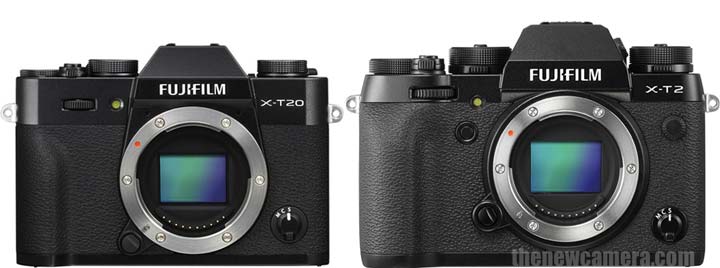
Technically the X-T20 carry same core specification as of the X-T2 camera and hence you will get same image quality from both the camera.
Why should you get Fuji X-T20 camera over the X-T2 ?
| Features / Models |
Fuji X-T20 |
Fuji X-T2 |
| Megapixel |
24 megapixels |
24 megapixels |
| Sensor size / type |
APS-C (23.6 x 15.6 mm) |
APS-C (23.6 x 15.6 mm) |
| Image processor |
X-Processor Pro2 |
X-Processor Pro |
| Low pass filter |
No |
No |
| Image stabilization |
No |
No |
| AF System |
Contrast detect + Phase detect |
Contrast detect + Phase detect |
| AF points |
325 points |
325 points |
| ISO |
100-51200 |
100-51200 |
| Shutter Min/Max |
60sec 1/4000 sec |
Shutter 30 seconds -1/8000 |
| Top Continuous Shooting Speed |
8/14 fps |
8/14 fps |
| Video |
4k @30fps |
4K @30fps |
| Display |
3.0 inch 1.04M-dot tilting TFT LCD Touchscreen |
3 inche 1.62 million dot LCD Monitor |
| Hot-shoe |
Yes |
Yes |
| Battery Life (CIPA) |
350 shots |
340 Shots |
| Wireless connectivity |
Built-In |
Wi-Fi, NFC |
| Weather Sealed |
No |
Yes |
| Dimensions |
118 x 83 x 41 mm |
139.0 x 105.2 x 78.5mm |
| Weight |
383 g |
650g |
More Frames, Better Display and More…
Fuji X-T2 features high resolution LCD screen and maximum shutter speed of Fuji film xt2 is also more compared to the X-T20 as well as the continuous shooting of X-T2 is approx 14 frames per second whereas the continuous shooting speed of the X-T20 camera remains limited to 8 frames per second only. The difference is very big if you are a sports shooter since you are losing 6 extra frames per second with the X-T20 camera.
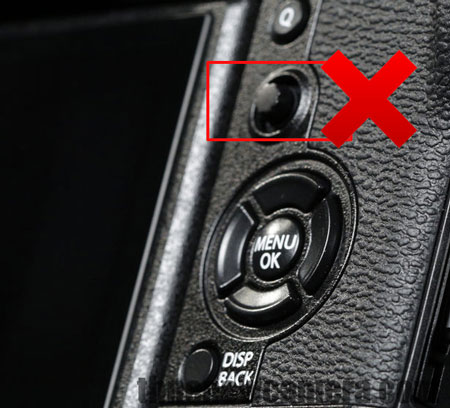
No Joystick in Fuji X-T20
Yes, the Fuji X-T20 camera doesn’t have Joystick like the X-T2 camera. So, this features doesn’t add a penny to image quality of the camera but it will sure help you to navigate your menus and select your desired AF points in a very easy manner.
Video
Well now let’s talk about the recording limit of both the camera. The recording time of both the camera is limited to 10 minutes in 4K mode, whereas if you use batter grip with your X-T2 it allow you to record 30 minutes video. If you select Full HD mode them both camera can record 15 minutes continues video.
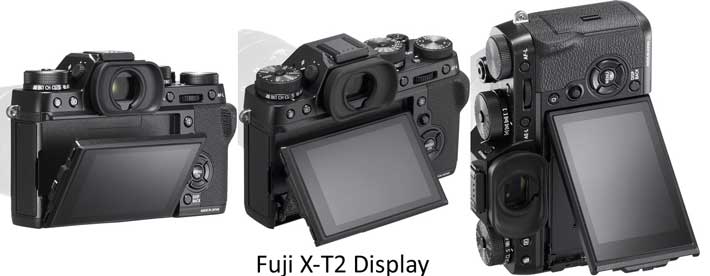
Display
Display of the camera are different and the major difference you will notice after getting in your hands is ouch sensitive display of the X-T2 camera and the X-T20 camera doesn’t have touch display.
Hence the Fuji X-T2 camera allow you to touch and shoot subjects on the go and helps you to navigate camera more quickly and easily compared to the X-T20 camera.
You Save $700
Yep, it’s a big plus point and with that money you can get a Fujinon 18-135mm f/3.5-5.6 ($699) – a perfect all rounder lens for your camera.
First and the biggest difference we notice is price. You get the X-T20 camera under $900 whereas you have to pay $1600 for the X-T2 camera. Despite of having such big difference in the price of both the camera you will get same image quality from both. camera features same sensor and image processor inside.
Verdict:
If you have pocket full of bucks then get X-T2 camera since it’s a marvelous machine, otherwise the trim-out version of the X-T2 / X-T20 will fullfill all your needs with bit of sacrifice in overall speed, Weather sealing and
Buy Fuji X-T20 from Amazon | B&H
Buy Fuji X-T2 from Amazon | B&H
Fuji X-T20 vs. Fuji X-T10
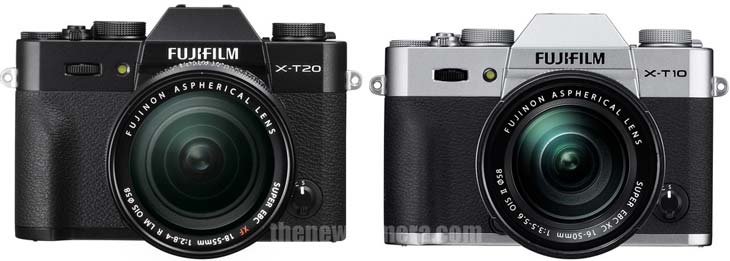
Lot of improvement done in X-T20 camera by Fujifilm, take a look at the detailed specification comparison review between these two camera
| Features / Models |
Fuji X-T20 |
Fuji X-T10 |
| Megapixel |
24 megapixels |
16.3 Megapixel |
| Sensor size / type |
APS-C (23.6 x 15.6 mm) |
APS-C (23.6 x 15.6 mm) |
| Image processor |
X-Processor Pro2 |
EXR Processor II |
| Low pass filter |
No |
No |
| Image stabilization |
No |
No |
| AF System |
Contrast detect + Phase detect |
Contrast + Phase detect sensor |
| AF points |
325 points |
77 Points |
| ISO |
100-51200 |
100-51200 |
| Shutter Min/Max |
60sec 1/32000 sec |
Shutter 60 seconds -1/32000 secs |
| Top Continuous Shooting Speed |
8fps |
8fps |
| Video |
4k @30fps |
1080p @60fps |
| Display |
3.0 inch 1.04M-dot tilting TFT LCD Touchscreen |
3.0″ 920k-Dot Tilting LCD Monitor |
| Hot-shoe |
Yes |
yes |
| Battery Life (CIPA) |
350 shots |
340 shots |
| Wireless connectivity |
Built-In |
Wi-Fi, NFC |
| Weather Sealed |
No |
No |
| Dimensions |
118 x 83 x 41 mm |
118 x 83 x 41 mm |
| Weight |
383 g |
381 g |
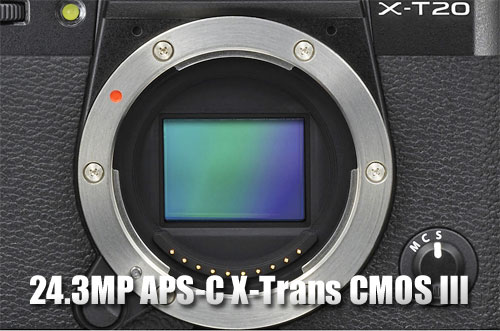
New Sensor
We have some major difference between the first and second generation of these cameras film X T20 camera features third generation of X-Trans CMOS sensor that features more AF points, resolution by maintaing the same ISO range.
With the help of new sensor you can select from 91 to 325 AF points. Hence you have approx entire area of the screen under AF. And hence you can spot and track your subject in no time.
With combination of latest XProcessor PRO camera the camera offers you continues shooting speed of 8 fps while using mechanical shutter and 14fps while using electronic shutter.
But, the top continues shooting speed of X-T10 camera remains limited to 8fps.
Extended Standard ISO Range
Fuji X-T10 camera standard ISO range is 200-6400 whereas the Fuji X-T20 features ISO range of 200-12800. The high ISO range of both the camera remains same.
Advance AF system:
By redesigning the AF algorithm from the ground up, the X-T20 can now autofocus more accurately on points of light, low-contrast objects and subjects with fine details such as bird feathers and animal fur. The read speed of the Contrast AF system, which covers approx. 85% of the entire frame, has been doubled*7 compared to the previous model to enable faster and more accurate autofocusing. During video recording, the AF point transitions smoothly to track a moving subject to create natural looking footage.
Shutter
The vertical grip of the X-T2 camera allow you to use mechanical shutter upto 11fps. Whereas there the X-T20 doesn’t have such facility. Despite of this slight difference the shutter speed of both the camera is almost identical 14fps with the electronic shutter or 8fps with the mechanical shutter.
4K video recording (4K vs Full HD)
The use of Fujifilm’s unique sensor and image processing engine enables both Full HD (1920 x 1080) and 4K (3840 x 2160) video recording. Set the Drive Dial to “Movie” and select the 4K Video mode in the menu to record 4K video at the high bitrate of 100Mbps. Full HD video can be recorded at 59.94 fps, 50 fps, 29.97 fps, 25 fps, 24 fps and 23.98 fps.
Verdict:
The Fuji X-T20 features a lot of big and small upgrades compared to the predecessor. Hence, we recommend you to get the Fuji X-T20 camera over X-T10.
Buy Fuji X-T20 from Amazon | B&H
Fuji X-T20 vs Fuji X-T1
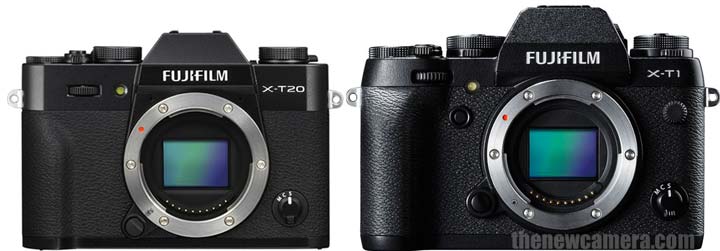
Undoubtedly the X-T1 was the flagship camera mirrorless camera a year ago but now the NEW Entry level X-T series camera is far better compared to that. let’s see the detailed specification for more details
| Features / Models |
Fuji X-T20 |
Fuji X-T1 |
| Megapixel |
24 megapixels |
16.3 Megapixel |
| Sensor size / type |
APS-C (23.6 x 15.6 mm) |
APS-C (23.6 x 15.6 mm) |
| Image processor |
X-Processor Pro2 |
EXR Processor II |
| Low pass filter |
No |
No |
| Image stabilization |
No |
No |
| AF System |
Contrast detect + Phase detect |
Contrast + Phase detect sensor |
| AF points |
325 points |
49 Points |
| ISO |
100-51200 |
100-51200 |
| Shutter Min/Max |
60sec 1/32000 sec |
Shutter 60 seconds -1/32000 secs |
| Top Continuous Shooting Speed |
8fps |
8fps |
| Video |
4k @30fps |
1080p @60fps |
| Display |
3.0 inch 1.04M-dot tilting TFT LCD Touchscreen |
3.0″ 1,040k-Dot Tilting LCD Monitor |
| Hot-shoe |
Yes |
Yes |
| Battery Life (CIPA) |
350 shots |
350 shots |
| Wireless connectivity |
Built-In |
Built-In |
| Weather Sealed |
No |
Yes |
| Dimensions |
118 x 83 x 41 mm |
118 x 83 x 41 mm |
| Weight |
383 g |
381 g |
New Sensor and AF System
We aren’t digging too much details here but as you know that the X-T1 uses IInd generation of X-trans sensor which features 16 MP resolution and only 49 AF points. Whereas, the III gen of X-Trans CMOS AF sensor carried a lot of design upgrades as well as new AF and image processing algorithm is implemented to outperform other flagship APS-C cameras of current generation.
The new sensor’s enhanced signal processing technology has even greater control over digital noise. Improved ISO sensitivity means ISO12800, only available as an extended ISO on the X-T10, is now available as a regular ISO option.
AF System
As we have already discussed that new sensor features more resolution and 325 AF points / you can select your AF points from 91 to 325 so you have a dense screen covered entirely with AF points. Whereas, the X-T1 limits itself with 49 AF points only.
4K Mode
The X-T20 is capable of recording both Full HD and 4K video using the X Series’ famous Film Simulation effects. Full HD video can be recorded at 59.94 fps, 50 fps, 29.97 fps, 25 fps, 24 fps and 23.98 fps. The X-T1 camera limited to Full HD videos at 60 FPS only.
ACROS mode
The Film Simulation function now features the ACROS mode. Using the X-Processor Pro’s advanced processing capability, the mode offers smooth gradation, deep blacks and beautiful textures to create monochrome images superior to the standard Monochrome mode.
Verdict:
We have seen a lot of upgrades in X-T20 camera, the X-T20 features new sensor and image processor and we are sure that the X-T20 camera is sully capable to give you BETTER IMAGE quality compared to X-T1. And hence, we recommend you to get the X-T20 camera over X-T1.
Buy Fuji X-T20 from Amazon | B&H
By admin, on December 21st, 2016
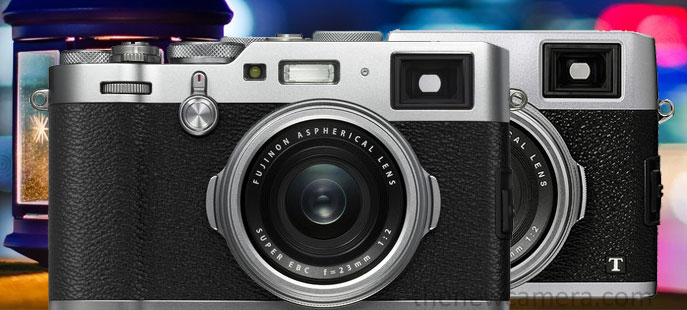
Fuji X100 arrived with extensive core specification, without a doubt we can say that Fuji X100F is leading APS-C camera of market. But, how much improvement does the X100F carry from inside to out side take a look now
While we look at both the camera the initial difference we notice is
Fuji X100F vs Fuji X100T Design Difference
- The AF led position changed
- Traditional Logo place has been also changed, Now we don’t see the F written in the place of T
- Addition of a front Jog dial button
- Rear Screen button shifted towards right Thumb, making more easy to operate the camera compared to its previous versions.
- On the rear side of the camera lot of changes has been made compared to the X100T.

we have marked with re square the front jog dial and the rear Joystick of the Fujifilm X100F camera. The camera also have a dedicated ISO dial at the top of the camera.
Fuji X100F vs Fuji X100T Specification Comparison
|
Fujifilm X100F |
Fujifilm X100T |
| Resolution |
24.3 million |
15.3 million |
| Sensor Version |
X-Trans III |
X-Trans II |
| Pixel Dimensions (large) |
6000 x 4000 |
4896 x 3264 |
| Standard ISO Output |
200 – 12,800 |
200 – 6,400 |
| Exposure Control |
Multi, Spot, Average, Centre |
Multi, Spot, Average |
| Exposure Compensation |
5 Stops |
3 Stops |
| Af Frame Selection |
Single, Zone, Wide / Tracking |
Single & Continuous |
| Film Simulations |
15 including Acros |
11 |
| Batteries |
NP-W126S |
NP-95 |
| Dimensions |
126.5mm (W) x 74.8mm (H) x 52.4mm (D) / 4.98in. (W) x 2.95in. (H) x 2.06in. (D) (Minimum Depth : 32.0mm / 1.26 in.) |
126.5mm (W) x 74.4mm (H) x 52.4mm (D) / 5.0 in. (W) x 2.9in. (H) x 2.1in. (D) (Minimum Depth : 31.0mm / 1.2 in.) |
| Weight |
419g |
400g |
| Digital Tele-Converter |
Yes |
— |
| Control Ring |
Yes |
— |
| Physical ISO Dial |
Yes |
— |
The camera features newly developed 24MP X-Trans III sensor and advance X Pro image processor. Hence with more resolution and advance generation of sensor architecture the X100F camera will give you more image quality with a extensive amount of details.
Despite of increase in resolution the X100F camera gives you 1-stop of more standard ISO range compared to the X100F camera.
Exposure control of the camera is also increased to 2 stops as well (a total of 5 stops) as AF frame selection of the camera is also rebuild and expended with three user selectable option based on the demand of scene Single, Zone, Wide / Tracking.
STAY WITH ON FACEBOOK | TWITTER | GOOGLE+ to get live news + Fuji rumors 24X7
Follow Fuji X100F Page on Facebook
By admin, on December 11th, 2016
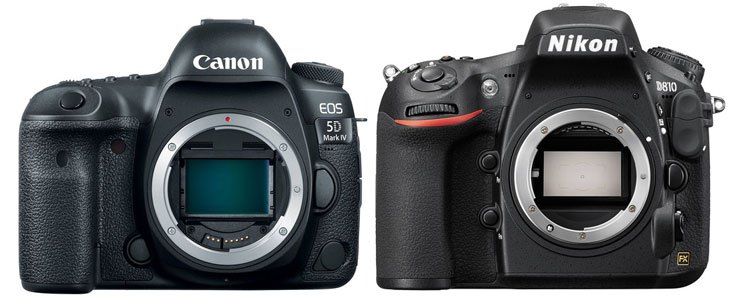
We are comparing Canon 5D Mark IV camera vs Nikon D810 camera to find out which camera is actually perfect for you need. Both camera are fullframe semi professional models and crafted for ultimate performance. We well have a detailed analysis of specification comparison and then Sensor test scores added with High ISO JPEG and RAW Test.
1. Specification Comparison
| Feature/Models |
Canon 5D Mark IV |
Nikon D810
|
| Megapixel |
30.4 MP
|
36 megapixels |
| Sensor size |
Full frame (36 x 24 mm) |
Full frame (36 x 24 mm) |
| Image processor |
DIGIC 6+
|
Expeed 4 |
| AF system |
Hybrid |
Hybrid |
| AF points |
61 |
51 |
| ISO |
50-102400 |
ISO 64-51200 |
| Shutter speed |
1/8000 to 30 sec
|
1/8000 to 30 sec |
| Image Stabilization |
No |
No |
| Continuous shooting speed |
7fps |
5fps |
| Video |
4K @30 fps |
Full HD 1080p Video Recording at 60 fps |
| Display |
3.2″ 1620K Touchable TFT-LCD
|
3.2″ 1,229k-Dot LCD Monitor |
| Hot shoe |
Yes |
Yes |
| Wireless |
Built-in, NFC |
Built-in |
| Battery life |
900 shots |
1200 shots |
| Weight |
890g |
980 g |
| Size |
151 x 116 x 76 mm |
146 x 123 x 82 mm |
Before we begin we must know that Nikon D810 sensor have extra 6 megapixels in it, that surely dig out more details compared to the Canon 5D Mark IV camera. The Canon 5D Mark IV offers 1 stop more ISO range compared to the Nikon D810 camera.
The AF system of the Canon 5D Mark IV is more advance compared to the Nikon D810 DSLR. The Canon 5D Mark IV camera offers Dual Pixel CMOS AF sensor whereas the Nikon DSLR features traditional CMOS AF sensor. Not only that Nikon Phase AF module also carried less AF points compared to Canon 5D Mark IV.
Canon 5D Mark IV also offers continuous shooting speed of 7 frames per second whereas the Nikon D810 remains limited to 5fps. The other big advantage we get with Canon 5D Mark IV is a option to record 4K videos.
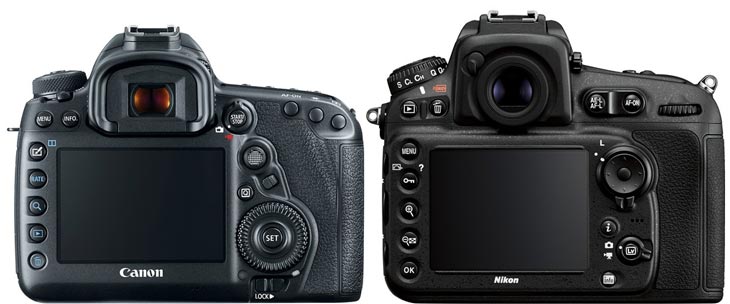
Canon 5D Mark IV arrived with full touch display unit as well as built-in WiFi on the other side Nikon uses traditional LCD display and no built-in WiFi.
Now let’s take a look at some real World Test Results
2. Canon 5D Mark IV vs Nikon D810 Sensor Test

While looking at the sensor test score of both the camera Nikon D810 look’s bi good compared to the Canon 5D Mark IV. Due to high resolution and Nikon FX format sensor the camera is able to deliver more dynamic range to you compared to Canon 5D Mark IV.
Canon 5D Mark IV score bit better marks in low-light ISO test compared to Nikon D810 DSLR camera.
3. High ISO Test JPG
Canon 5D Mark IV vs Nikon D810 JPEG High ISO Test
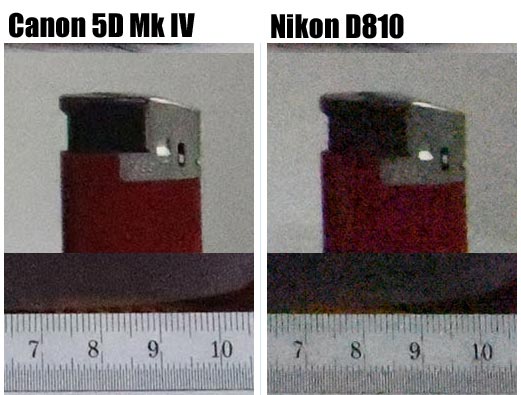
Nikon D810 showing extensive amount of noise in the image when compared to Canon 5D Mark IV. Both camera was set at ISO 51200 while capturing this shot, the Canon 5D Mark IV was using Canon EF 24-105mm F4 L IS USM Lens and the Nikon DX810 was using AF-S Nikkor 24-70mm F2.8G ED Lens.
4. RAW file Test
Canon 5D Mark IV vs Nikon D810 RAW High ISO Test
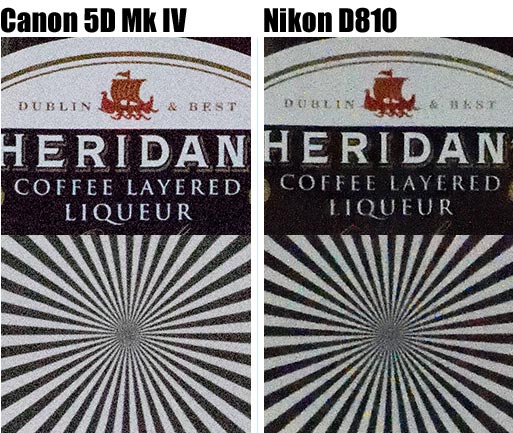
Both the image was captured on RAW format @ ISO 51200. As you can see in the left image captured by Canon 5D Mark IV showing more details and clarity compared to the image captured by Nikon D810.
5. Price Difference
Nikon D810 will cost you $1K approx less compared to Canon 5D Mark IV which is a big difference for sure. The big difference in budget can sure turn-around anyone mind who is panning to buy one between these two rivals.
6. Verdict: Winner Canon 5D Mark IV
based on specification comparison review and after looking at the test samples of both the camera we recommend you to get the Canon 5D Mark IV camera. It’s one of the best camera available for professional shooters.
Also look at – Canon 5D Mark IV Best Lenses
Canon EOS 5D Mark IV available at —- Amazon.com | B&H Store
Get Nikon D810 from Amazon.com
Source – DXOMARK LAB | dkamera.de
By admin, on November 10th, 2016
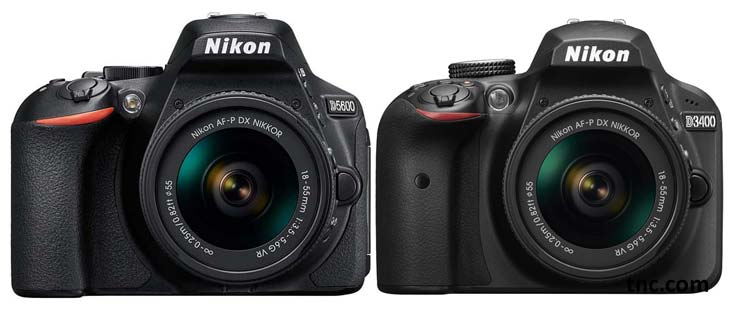
Nikon D5600 does have some significant improvement over the Nikon D3400 camera, take a look at the table below for more details.
Nikon D5600 vs Nikon D3400 Specification Comparison Table
| Features / Models |
Nikon D5600
|
Nikon D3400 |
| Megapixel |
24 megapixels |
24 megapixels |
| Sensor size / type |
APS-C (23.5 x 15.6 mm) |
APS-C (23.5 x 15.6 mm) |
Image processor
|
Expeed 4 |
Expeed 4 |
| Low pass filter |
No |
No |
| Image stabilization |
No |
No |
| AF System |
Contrast + Phase Detect sensor |
Contrast detect+Phase detect |
| AF points |
39 points |
11 points |
| ISO |
100-25600 |
100-25600 |
| Shutter Min/Max |
30sec 1/4000 sec |
30 sec 1/4000 sec |
| Top Continuous Shooting Speed |
5fps |
5fps |
| Video |
1920 x 1080 (60p,24fps) |
1920 x1080 (30, 25, 24 fps) |
| Display |
3.2″ Rear Touchscreen vari-angle LCD (1,037,000) |
3.0″ TFT- LCD Rear Screen (921K pixels) |
| Viewfinder |
Optical Viewfinder (95%) |
Optical Viewfinder (95%) |
| Hot-shoe |
Yes |
yes |
| Battery Life (CIPA) |
480 shots |
1200 shots |
| Wireless connectivity |
Built-In, Nikon snapbridge |
Built-In Wi-Fi, Nikon Snapbridge |
| Dimensions |
124 x 97 x 70 mm
|
124 x 98 x 76 mm |
| Weight |
420g |
395g |
Unfortunately the sensor resolution, sensor size and the ISO range of both the sensor is same and without a doubt it is very clear that the image quality of both the camera will remains same despite of model difference.
The image processing unit of both the camera is Expeed 4 and the shooting speed of the both the camera is also same.
The only visible advantage in Nikon D5600 camera is advance AF system used inside the Nikon D5600 DSLR. The Nikon D5600 camera features 39 point AF system and the Nikon D3400 DSLR features 11 point AF system. hence more screen coverage directly means you will able to cover your subject more effectively and quickly with loosing it from AF area of from the shooting frame.
And the other advantage of D5600 is Rear LCD screen of the Nikon D5600 is vari-angle and touchable.
1200 shots capability of Nikon D3400 is truly amazing, the Nikon D5600 battery life remains limited to 480 shots only.
Verdict: Based on specification comparison review it’s very clear that Nikon D5600 sensor and image processor remains same, but at the same time you will get better AF system with the camera. Nikon D3400 battery backup is amazing and enough for shooting a entire event without replacing the power source. We recommend you to get Nikon D5600 is you need advance AF system otherwise the Nikon D3400 is sufficient for producing great photos.
Buy Nikon D3400 from Amazon | B&H
By admin, on November 10th, 2016
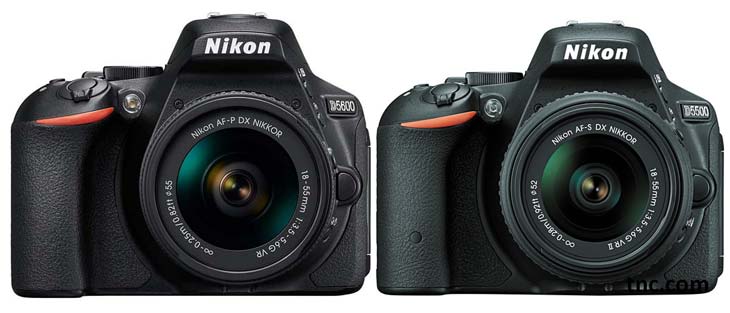
Nikon D5600 vs Nikon D5500 specification comparison review is really a hard task for us and you will also feel the same when you will look at the specification comparison table of the camera.
Nikon D5600 vs Nikon D5500 – Specification Comparison
| Features / Models |
Nikon D5600
|
Nikon D5500 |
| Megapixel |
24 megapixels |
24 megapixels |
| Sensor size / type |
APS-C (23.5 x 15.6 mm) |
APS-C (23.5 x 15.6 m) |
Image processor
|
Expeed 4 |
Expeed 4 |
| Low pass filter |
No |
No |
| Image stabilization |
No |
No |
| AF System |
Contrast + Phase Detect sensor |
Contrast detect+Phase detect |
| AF points |
39 points |
39 points |
| ISO |
100-25600 |
100-25600 |
| Shutter Min/Max |
30sec 1/4000 sec |
30 sec 1/4000 sec |
| Top Continuous Shooting Speed |
5fps |
5fps |
| Video |
1920 x 1080 (60p,24fps) |
1920 x1080 (30, 25, 24 fps) |
| Display |
3.2″ Rear Touchscreen fully articulated LCD (1,037,000) TFT |
3.2″ Rear Touchscreen Swivel LCD (1,037,000) |
| Hot-shoe |
Yes |
Yes |
| Battery Life (CIPA) |
NA |
480 shots |
| Wireless connectivity |
Built-In, Nikon snapbridge |
Built-In Wi-Fi |
| Dimensions |
124 x 97 x 70 mm |
124 x 97 x 70 mm |
| Weight |
465 g |
420g |
Identical twins?
The word Identical twins is too perfect and we should say it both DSLRs core specification are mirror image of each other. As far as I remember few good rumor sources stated in the past that Nikon D5600 is coming with the same sensor as of Nikon D7200 and that will result increase in dynamic range of the camera compared to its predecessor. So, we have to wait till the DXO lab test out the new D5600 camera.
Yes there are some advantages as we have mentioned in green tabs. The Nikon D5600 features 3.2″ fully articulated LCD which is better then the Swivel display unit and snapbridge connectivity support, but none of these things will help you to improve image quality.
Verdict: For Nikon D5500 we strictly say to you that you shouldn’t buy the Nikon D5600 camera you and should wait for a better camera like Nikon D5700
By admin, on October 17th, 2016
 Sony RX100 V vs. Canon G7X Mark II Specification comparison and High ISO Test – Sony RX100V resolution and sensor size may look same. But both models have entirely different sensor inside. The Canon G7X Mark II have a traditional contrast detect sensor whereas the Sony RX100 V features hybrid Phase+contrast detect sensor. And not only that RX100 V does have series of modification to look. We have also done a side by side test to to see which camera actually produces better images Sony RX100 V vs. Canon G7X Mark II Specification comparison and High ISO Test – Sony RX100V resolution and sensor size may look same. But both models have entirely different sensor inside. The Canon G7X Mark II have a traditional contrast detect sensor whereas the Sony RX100 V features hybrid Phase+contrast detect sensor. And not only that RX100 V does have series of modification to look. We have also done a side by side test to to see which camera actually produces better images
Specification Comparison
| Features / Models |
Sony RX100 V
|
Canon G7X II
|
| Megapixel |
20 megapixels |
20 megapixels |
| Sensor size / type |
1″ (13.2 x 8.8 mm) |
1″ (13.2 x 8.8 mm) |
| Image processor |
Bionz X |
Digic 7 |
| Low –Pass filter |
Yes |
|
| Image stabilization |
Optical |
Optical |
| AF System |
Contrast + Phase Detect sensor |
Contrast Detect (sensor) |
| AF points |
315 points |
31 points |
| ISO |
125-25600 |
125-25600 |
| Shutter Min/Max |
30 sec 1/32000 sec |
30 sec 1/2000 sec |
| Top Continuous Shooting Speed |
24fps |
8fps |
| Video |
3840 x 2160 (30p, 25p, 24p) |
Full HD 1080p @ 60 fps |
| Display |
3.0″ 1.23m-Dot 180° Tilting LCD |
3.0″ 1.04m-Dot Tilting LCD Touchscreen |
| Viewfinder |
Electronic |
None |
| Battery Life (CIPA) |
220 shots |
265 shots |
| Wireless connectivity |
Built-In |
Built-In |
| Dimensions |
102 x 58 x 41 mm |
106 x 61 x 42 mm |
| Weight |
299 g |
319g |
As we have told you earlier the sensor inside the Sony RX100V features 315 Phase AF points to quickly lock down AF on subjects despite of lighting condition.
The most important part of the new Sony RX100 V camera is the introduction of LSI circuit inside the camera that increase the frame rate of the camera upto 24frames per second. And not only that with the help of large buffer we have 148 JPEG frames in a single burst. The same tech also help to capture Full HD video @ 120frames per second and HFR Mode for Full HD Video up to 960 fps.
World fastest AF in a compact camera – The 60% of the display screen of the camera is covered by the the 315 Phase AF points. The RX100 V is able to lock onto subjects quickly, in just 0.05 seconds, and it can use AF tracking when shooting at 24 fps. Sony RX100V world most fastest compact camera till date.
Shutter: Sony RX100V uses Hybrid shutter, with the help of Hybrid shutter the shutter range of Sony RX100V goes from 30 sec to 1/32000 sec whereas the Canon shutter range remains limited to 1/2000 sec.
Video Mode: If We talk about the video mode the Sony RX100 V will win the fight without an issue. The Sony RX100V camera can capture 4K video mode whereas the Canon G7X Mark II remains limited to Full HD video mode only. Sony RX100V can also use Hybrid AF system while shooting video.
On the rear side of the Canon G7X Mark II camera we have a touch screen display that allow users to touch and focus your subjects, whereas the Sony RX100M V doesn’t have touch screen display.
The Cost: The Big Cost of the camera is also very important. The Canon G7X Mark II available in $699 only and the Sony RX100V is available on $999. So you have to pay $300 extra is you want Sony RX100V camera
Sony RX100 V vs. Canon G7X Mark II High ISO Test
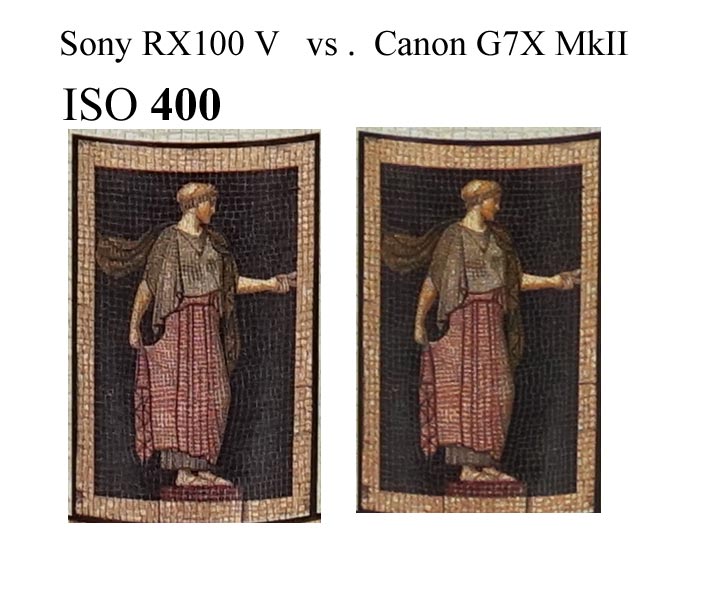 Sony RX100 V vs. Canon G7X Mark II – High ISo test between Sony RX100 V vs Cann G7X Mark II camera at ISO400 If you want to really see the difference between these two camera look at the test images captures at ISO 400 very carefully. The Sony RX100 V camera showing excellent details even when viewed at 100% whereas the Canon G7X Camera on the right side fails to collect the amount of details / maybe due to the strong noise reduction filter inside it.
However the bottom line at base ISO range Sony is producing bit more details compared to Canon G7X Mark II.
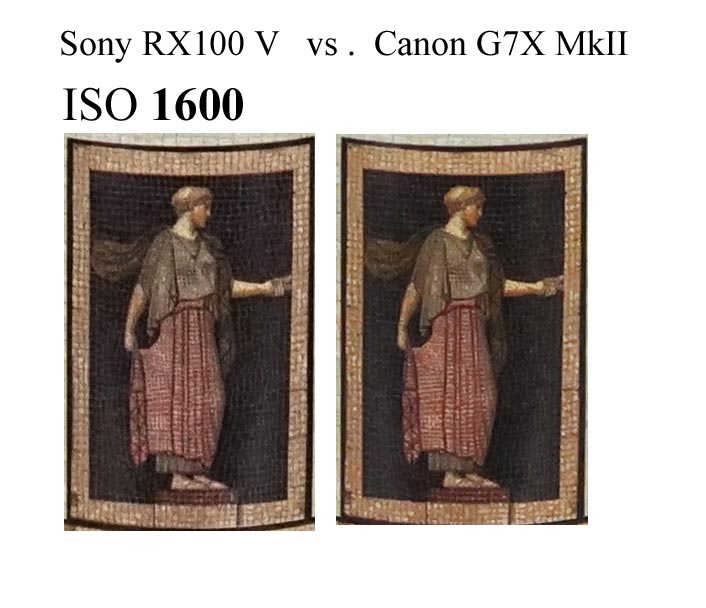 Sony RX100 V vs. Canon G7X Mark II – ISO 1600 Now after that in each test you can see the result, Sony RX100V capturing more details and Canon G7X Mark II images look bit flat.
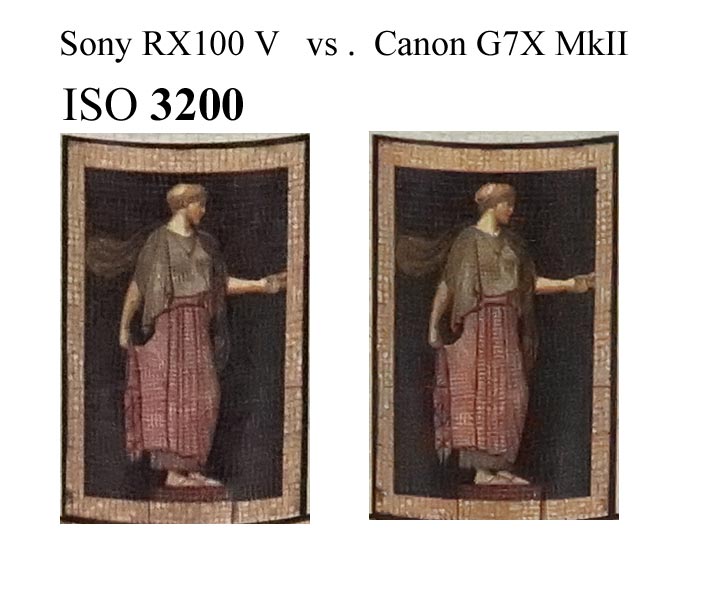 Sony RX100 V vs. Canon G7X Mark II – ISO 3200 Both camera giving flat details at ISO 3200 however there is no sign of color noise which is really a big advantage for a compact cameras. However we are not able to see any noticable change between the image quality of both the camera at ISO 1600 and ISO 3200.
 Sony RX100 V vs. Canon G7X Mark II – ISO 12800 Before we begin I must say that both the camera producing unusable image at ISO 12800, but at the same time we can say the color noise of Sony RX100V is more controlled than Canon G7X Mark II.
Verdict
Sony done a lot of homework to improve the overall specification the camera, one of the eye-catching specification is RX100 V is able to do AF even at 24frames per second and can save 120frames in a single burst. The other biggest advantage is 4K video mode (supported by Hybrid AF) as well as HFR mode that allow you to capture Full HD Video up to 960 fps. Whereas the competitor Canon G7X Mark II remains limited to Full HD videos at 60fps only.
The new sensor of the Sony RX100 V camera giving us more details at base ISO range compared to Canon G7X Mark II however the ISO test sample images captured at ISO 3200 and ISO 1600 look bit similar.
I will prefer Sony RX100 V camera over Canon G7X Mark II. Since the RX100 V features ultra advance core specification that includes, better sensor, Hybrid AF, global Shutter, 4K video as well as HFR video, a far better core specification compared to G7X Mk II.
Buy Sony RX100 V from Amazon | B&H
Buy Canon G7X Mark II camera from B&H
High ISO test Image credit: imagineresource.com
By admin, on October 12th, 2016

Sony RX100 V is a supercompact camera powered by 1″ Hybrid sensor on the other side we have Sony RX100 IV camera that built with the same contrast detect technology that is being used in all RX100 series camera before the announcement of RX100V. It’s a very clear indication that the Sony RX100 V does arrived with a big change.
Sony RX100 V vs Sony RX100 IV Specification Comparison Review
| Features / Models |
Sony RX100 V |
Sony RX100 IV |
| Megapixel |
20 megapixels |
20 megapixels |
| Sensor size / type |
1″ (13.2 x 8.8 mm) CMOS |
1″ (13.2 x 8.8 mm) |
| Low –Pass filter |
Yes |
Yes |
| Optical zoom |
2.9x |
2.9x |
| Aperture Range |
F1.8 – F2.8 |
F1.8 – F2.8 |
| Image stabilization |
Optical |
Optical |
| AF System |
Contrast + Phase (Hybrid sensor) |
Contrast Detect (sensor) |
| AF points |
315 AF Points |
25 points |
| ISO |
80-12800 |
125-12800 |
| Shutter Min/Max |
30 sec 1/32000 sec |
30 sec 1/32000 sec |
| Top Continuous Shooting Speed |
24.0 fps |
16fps |
| Video |
3840 x 2160 (30p, 25p, 24p) |
3840 x 2160 (30p, 25p, 24p) |
| Display |
3.0″ LCD Rear Screen (1,228,800 pixels) |
3.0″ LCD Rear Screen (1,228,800 pixels) |
| Viewfinder |
EVF 100% |
EVF 100% |
| Hot-shoe |
No |
No |
| Battery Life (CIPA) |
220 shots |
280 shots |
| Wireless connectivity |
Built-In with NFC |
Built-In with NFC |
| Dimensions |
102 x 58 x 41 mm |
102 x 58 x 41 mm |
| Weight |
299 g |
298g |
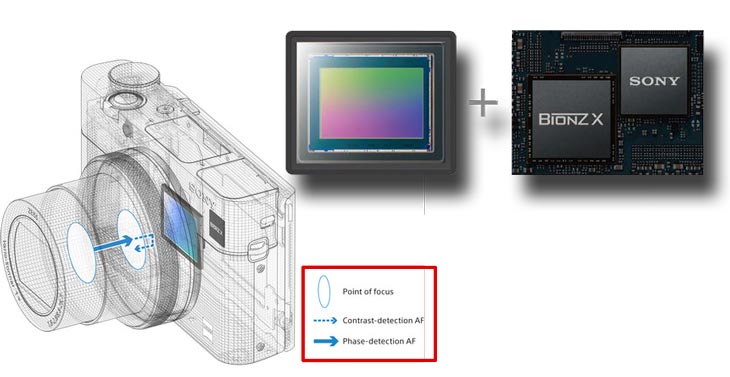
The sensor of both the camera features same resolution. And the ISO range of both the camera is almost same. But the biggest difference is fabrication of Phase AF points inside the sensor of Sony RX100 V camera. The sensor of the camera carries 315 AF points that helps to lock down AF in no time.

Sony added new integrated DRAM chip on the camera that improves speed of processing, it help buffer to increase its speed and limit. Hence with the Sony RX100V you can capture 24frames a second @ 20 Megapixels.
The other major addition is front-end LSI. LSI means Large scale integration of transistors. By adding front-end LSI and DRAM chip the overall performance, image & video quality of the Sony RX100 V will be greatly improved compared to its predecessor.
The Hybrid AF system of the camera will help users to do blazing fast AF while recording videos. And I hope this time the RX100 V is free from overheating and other issues as faced by Sony RX100 MIV users while recording 4K videos.
Short Battery can emerge as a big problem to Sony RX100V users since 220 Shots limit can be crossed any time while shooting a event or when you are traveling outside. So we suggest to keep extra battery pack always when you have RX100V.
Verdict:
Sony RX100 V camera contains a lot of improvement from inside. The Sony RX100V camera new sensor with Hybrid AF points, front-end LSI and DRAM Chip for performance improvement. We recommend you to get Sony RX100V camera over RX100IV.
Buy Sony RX100 V from Amazon | B&H
Buy Sony RX100 IV from Amazon | B&H
|
KEEP THIS BLOG ALIVE - Support New Camera Buy Canon Lenses, Buy Music CD or Digital Camera at amazon it helps this site, and you do not pay anything extra, it is just a way to help support this site.

|

















 Sony RX100 V vs. Canon G7X Mark II
Sony RX100 V vs. Canon G7X Mark II 










